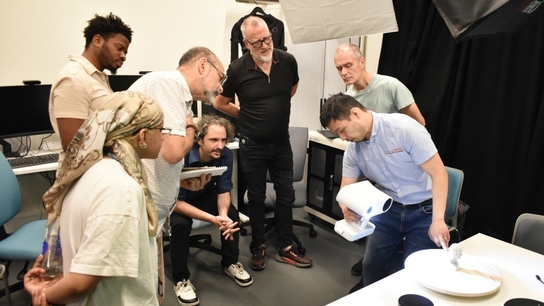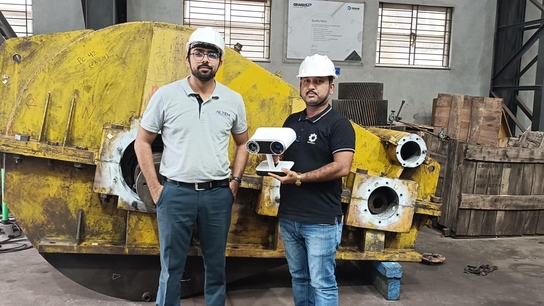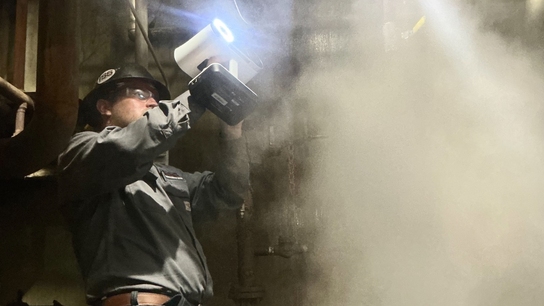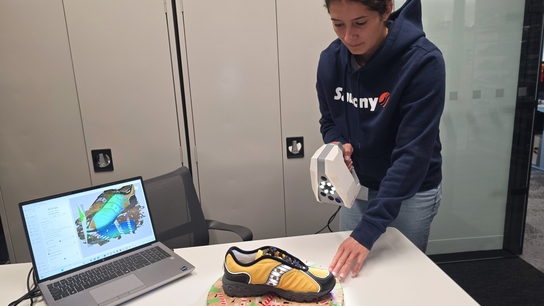Artec Space Spider and Control X unlock faster, more accurate manufacturing
Summary: Multistage manufacturing can introduce uncertainty and process deviation that lead to inaccurate end part results. Corrective investigations are difficult unless a systematic approach with the proper tools is used.
The goal: To use an Artec 3D Space Spider scanner and Geomagic Control X metrology and quality management software by 3D Systems to reduce total costs and project time, heighten accuracy, and exceed foundry expectations with minimum iterations.
Tools used: Artec Space Spider, Artec Studio, Geomagic Control X
Scanning and inspecting additively manufactured parts results in reduced costs, minimized iterations, and improved accuracy and quality.
As new production technologies evolve, new technical challenges arise in manufacturing the best possible part. Oftentimes, significant tuning of the new process is required the first time a contract manufacturer attempts production in order to understand elements such as shrinkage, surface finish, and repeatability. Additive manufacturing is no exception and yet tools to track these elements for this production methodology have lagged behind. That is now changing.
Most manufactured goods follow a common process through their lifecycle to production. Design, Manufacture, and Inspection is a generalized way to consider processes, stages, and responsibilities, each one being key to producing high-quality parts. Depending on the complexity and nature of the part being manufactured, the real workflow can have many tuning loops and feedback.
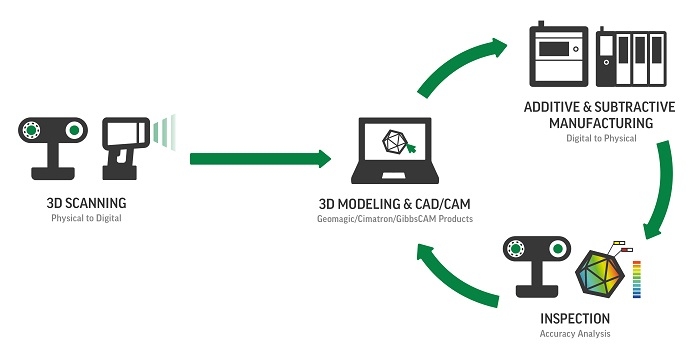
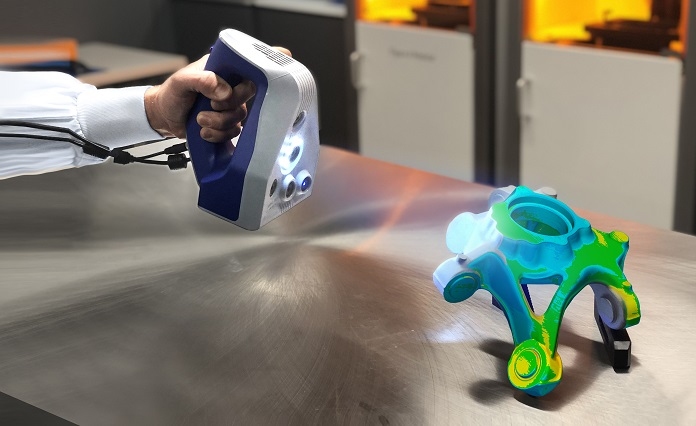
In our workflow example below, we demonstrate how Artec Space Spider & Geomagic software together provided total shape capture and analysis on 3D printed wax casting patterns and cast parts, at all stages in the design, prove out, and manufacturing process.
CHALLENGE
Multistage manufacturing can introduce uncertainty and process deviation, which accumulate into end-part results that are not accurate. Corrective investigations are challenging to perform unless a systematic approach is taken with the proper tools
SOLUTION
Artec 3D Space Spider scanner and Geomagic® Control X™ metrology and quality management software by 3D Systems
RESULTS
- Refining the additively-manufactured, tool-less pattern process with 3D scanning and inspection nets improved results with minimum iterations (one)
- 27% reduction in cost with a 10% increase in total accuracy
- Close working relationship with a foundry, and analysis of the casting process nets finished parts which exceed foundry expectations with minimum iterations (one)
- 14% increase in end part accuracy
- Reduction in finishing cost with reduced secondary machining operations

Artec Space Spider is an ultra-high-resolution handheld 3D scanner that excels at precisely capturing small objects and complex details for dimensional inspection.
With plug-and-play operation, Space Spider scans objects easily, without complicated preparation and extensive user training, allowing customers to digitize parts anywhere. Artec 3D’s proprietary “target free” algorithms allow the scanner to track the object by its shape and color alone. No need to apply targets to the object.
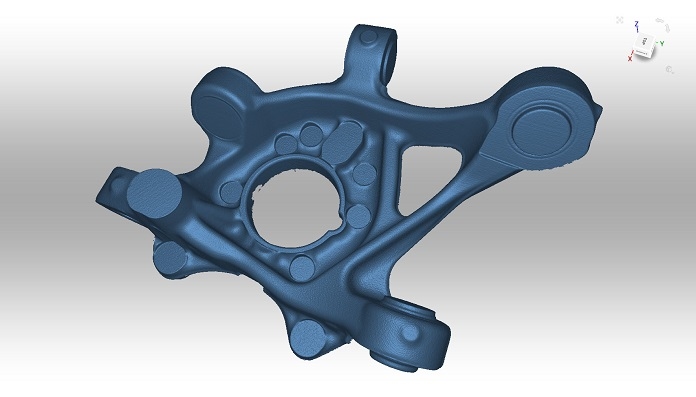
Artec Studio scanning software
Geomagic Control X is industrial metrology software that enables root cause analysis and correction for manufacturing, as 3D scan–native software, Control X is an ideal solution for metrology with portable measurement devices. With Control X, more people in your organization can measure faster, more often, more completely, and anywhere.
The total solution provides unique insight into successful production in a complex manufacturing process. The result? Greatly improved overall final part quality, accuracy, and repeatability.
Design
For this workflow example, we replicated a real customer project but generalized the details. In this case, our customer was developing a specialized autonomous-driving, light-duty vehicle. In order to speed time-to-market, a range of components and systems from vehicles on the market today were selected and combined to complete a working prototype. In this process, they found a specific steering knuckle that was of value to the project, and the customer needed to digitize and capture the design for further modification and production in a lightweight material.
To begin work, the original casting was 3D-scanned and reverse-engineered. Artec Space Spider was used for rapid digitization, and the part was quickly and accurately modeled in Geomagic Design X using a unique hybrid modeling approach. Typically our customers will follow either an as-built (very accurate) or design intent (dimension-driven) modeling method. A hybrid modeling approach consists of combining both of those concepts to deliver a CAD solid model result that has both dimensioned features as well as highly accurate NURBS surfaces. Using this strategy, the model was completed in under 1.5 hours and live-transferred to SOLIDWORKS as feature-based CAD.

Original Part Scan
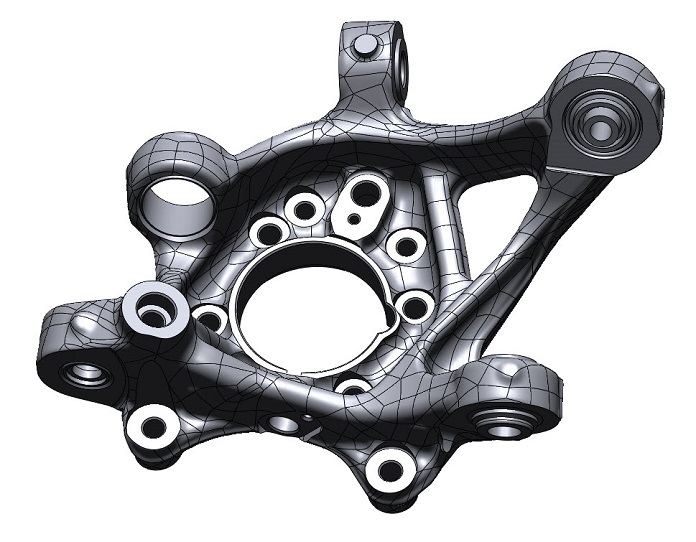
Hybrid CAD Model
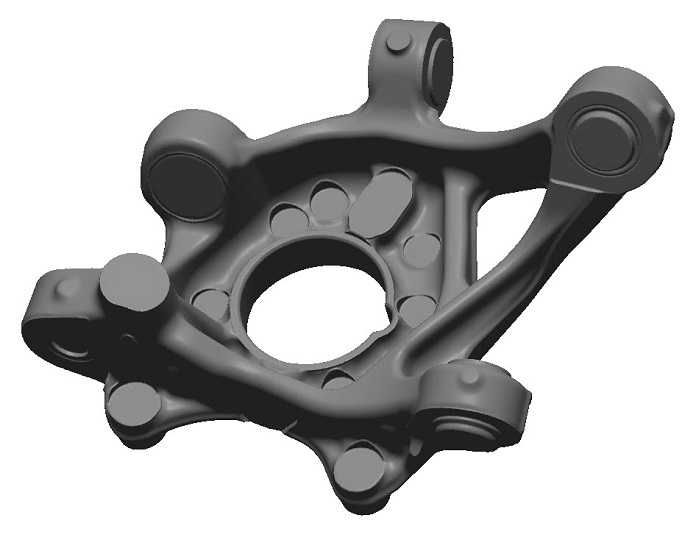
Defeatured Model for Print
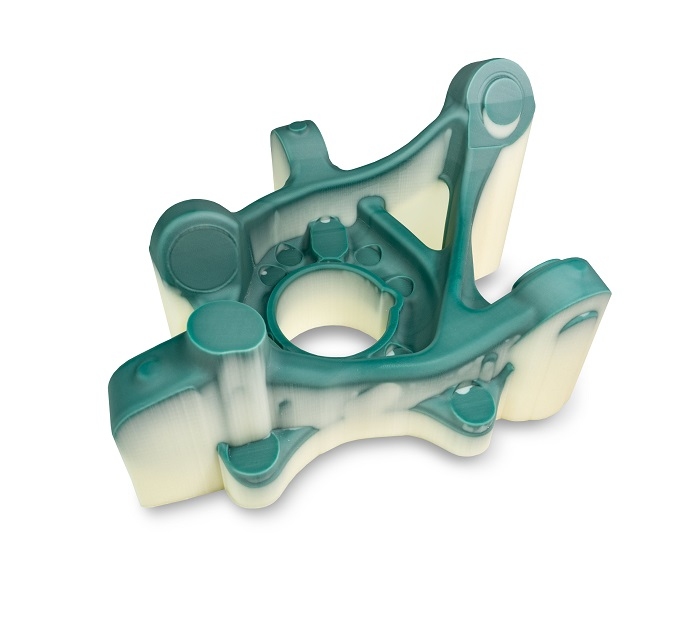
Unfinished 2500 IC Print
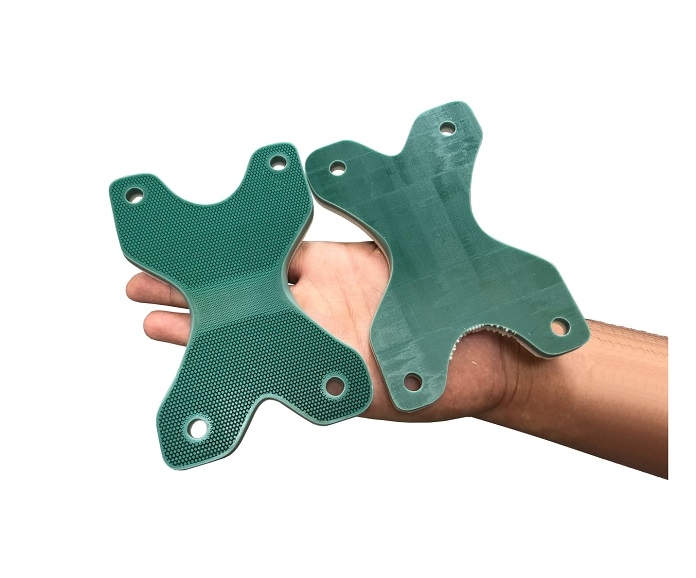
Example Cross Section of Sparse Infill Mode on Projet 2500 IC
Pattern-making
Additive Manufacturing has been used in aerospace and automotive applications to produce sacrificial casting patterns for decades. With recent advances in 3D printing, industrial-grade patterns can be printed in wax or polymer at significantly lower cost, which works seamlessly in the investment casting process. Today 3D Systems is seeing more distributed adoption of tool-less additive pattern making, and with that will continue to grow as the technology becomes more accessible, rapid, and precise.
For any additive process that involves heat energy in material deposition, or post-processing, there is some amount of part warp and “settling” that can potentially occur. Parts that have significant mass, or significant cross-sectional area, will retain heat for longer than smaller or thinner parts.
Based on this knowledge, we tested two printing methods with the goal of having the lowest possible cost of printed goods, and the highest level of dimensional stability. We tested a completely solid wax printing method as well as a thin shell/sparse wax infill method, prepared by 3D Sprint build client software and printed on the Projet MJP 2500 IC system, which produces wax casting patterns. From prior experience, we found that a 2mm shell with a 50% sparse infill ratio produces high-quality stable parts when printing relatively large parts.
After post-processing and cooling time, our two patterns were scanned with the same Artec Space Spider with relative ease. The unique shape of the parts, green wax color, and slight dulling and whitening effect of the post process allowed our scanning technician to smoothly capture the models using Geometry + Texture tracking.
Using Geomagic Control X, we imported our 3D Sprint Build file directly and inspected each part in its exact print orientation for the inspection routine. Knowing that we would be scanning our subject part iteratively to improve our process, we were able to set up one detailed inspection project and duplicate it several times while maintaining the entire process development history in a single Geomagic Control X file. When scans were complete, we simply dropped each new STL file into the Control X project and the evaluation process automatically took over, resulting in high-quality, repeatable reports.
We found that generally, all areas with machining offsets were within the casting tolerance, but the more freeform areas presented trends outside a tight tolerance band. We believe this properly correlated with our assumptions that large cross-section areas retain heat and potentially change shape when cooling.
Our comprehensive analysis for this stage helped us draw some conclusions that 3D printing with the wax pattern was not only more cost-effective but also more dimensionally-compliant after post-processing.
Casting
Investment casting is a trusted manufacturing methodology dating back 5,000 years and established in global industrial manufacturing for the last few hundred years, since the dawn of the Industrial Revolution.
Today, the casting process is quite mature and repeatable, well-known, and covered by simulation software to help reduce the chance of internal part defects. With an experienced foundry partner and minimal effort on the customer side, it’s possible to deliver additively manufactured patterns and produce parts that are free of internal defects and generally exceed commonly held process tolerance expectations for casting.
Customers who actively participate in testing of the result and process iteration can expect to achieve significantly higher quality output when tuning their part geometry, due to the stability of the casting process itself.
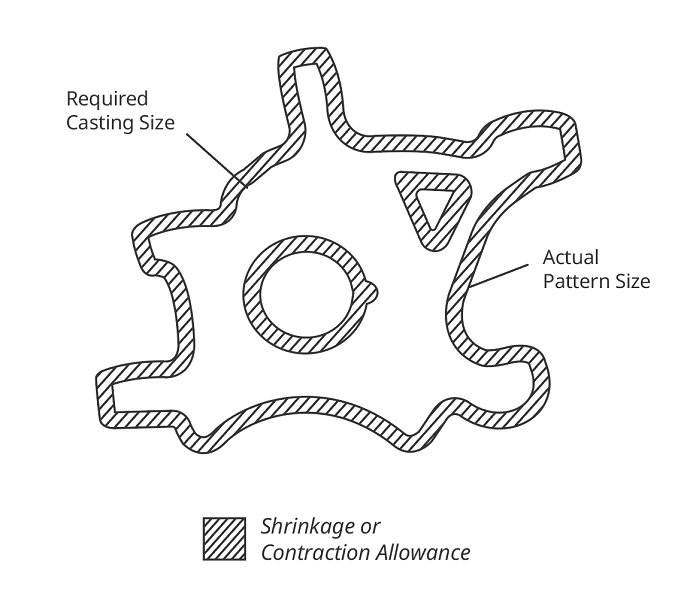
Required Casting Size, Actual Pattern Size
- ~ 35% less part material used in the process.
- ~ 27% material cost reduction.
- ~ 10% increase in overall compliance with tolerances (using 3D Comparison).
- Solid part did not pass our tolerance threshold.
- Infill part passed our tolerance threshold.
Additionally, further investigation showed that long-term dimensional stability at room temperature was improved over the solid part.
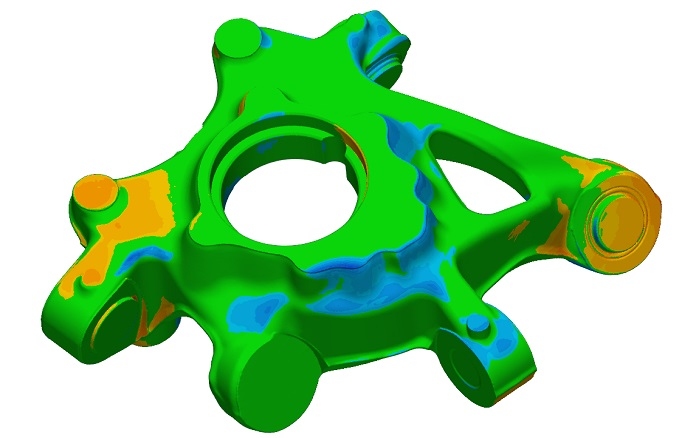
Analysis: Solid Wax Pattern
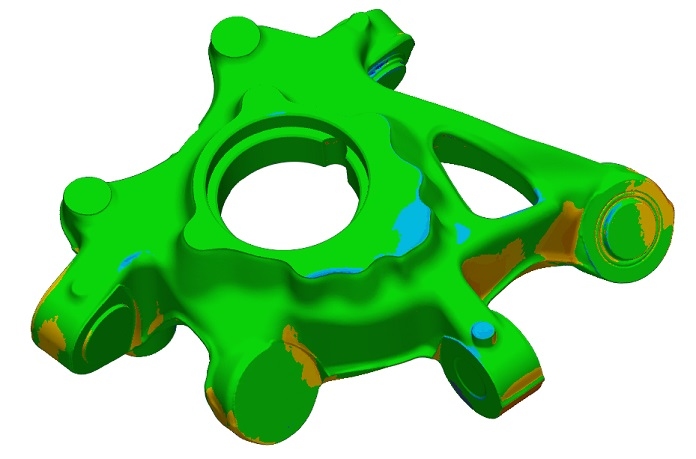
Analysis: Wax Pattern with Infill
Shrinkage is a known result of the casting process and typically a foundry provides some guidance to customers in order to compensate for the known shrinkage for a specific material, for a part size defined by bounding box. Due to the complexity of geometry and compounded by the physical casting process, it is common to see non-uniform shrinkage with most parts. As a result, casting can generally be regarded as a “loose tolerance” process.
During the casting processes for our steering knuckle, we investigated a shrinkage rate that would be suitable for our model and material. After consulting with the casting facility, a 2% uniform scale was recommended to produce an accurate part. To investigate the effect that 3D scanning and a precision scale factor can have on end-part accuracy, we produced a wax pattern with a 2% scale factor as advised, and supplied it to the foundry.
Further inspection on the returned castings was performed to verify if the uniform scaling factor conformed to expected tolerances. Following the generalized foundry specification, it provided a part which was definitely inside our partner’s stated achievable accuracy parameters. However, closer inspection with the Cross Section compare tool in Control X indicated some obvious areas where better application of the precision scale factor could meaningfully improve the overall accuracy of the finished part.
This Cross Section Silhouette comparison with a tight tolerance band clearly shows outer borders with blue coloring, and inner borders are showing orange and red coloring. The outer profile is confirming an “undersize” condition where the actual part boundary is inside the reference boundary. The inner profile is showing that center cylinder feature is dimensionally smaller than intended, but appearing as outside of the reference feature. This indicates that the total silhouette shadow of the part has a scale difference which can be corrected by increasing the scale factor, printing, and casting again.
Previous casting process improvement investigations have given us some insight on relative adjustments from recommended standard values that we can apply, and a second wax pattern was printed with a non-uniform scale factor of 2.2%, 2.3%, and 2.7% in X, Y, and Z, respectively, and supplied to the foundry.
With a final inspection on the precision compensated pattern, we were able to draw some conclusions about the pattern-to-part process:
- The precision scaled pattern provided results that exceeded foundry expectations.
- Overall dimensional compliance of the scale corrected part increased by ~14%.
- At least one major machining operation could be avoided with the increase in precision.
- Total overall part production cost was reduced.
- Future analysis is needed to see if further precision can be applied to generally reduce machine operations.
Conclusion
Efficiency is key in maintaining profit and reducing waste in human cycles and manufacturing cycles. With Artec 3D Space Spider and Geomagic Control X, we were able to improve the total overall quality of our manufactured part by analyzing each stage of our process, with the minimum possible tuning cycles and iteration. Reducing iteration and guesswork, saving time and money, and faster time to market are key benefits of using a total solution for high-quality 3D Scanning and Scan-native Industrial Inspection software.
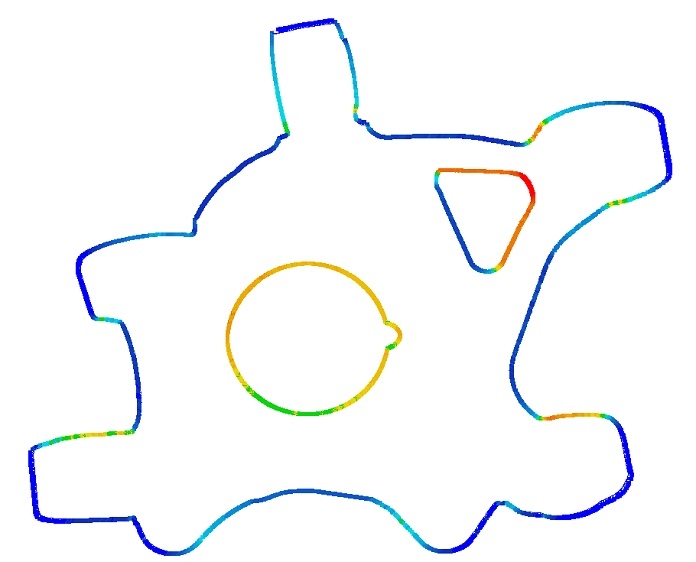
Analysis Cross Section of Scale Error

Final Cast Part
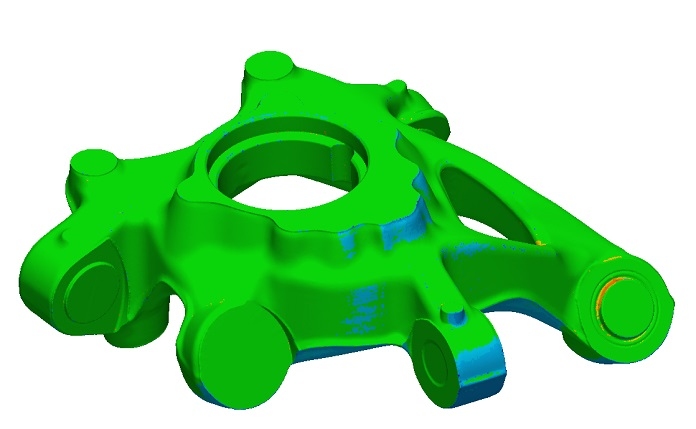
Analysis of Final Casting
Scanners behind the story
Try out the world's leading handheld 3D scanners.

